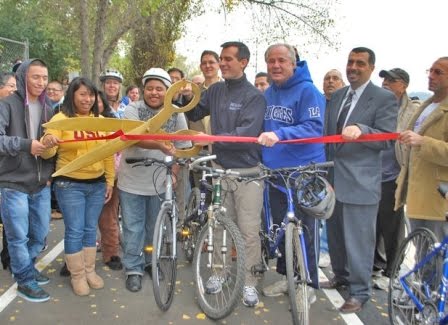Quick quiz: Are you a left-brained cycling advocate or a right-brained cycling advocate? Here's how to find out: If someone asks why you ride, do you talk about the wind in your hair and the sense of satisfaction achieved by pedaling up a hill? If so, you're doing it wrong. If you want to sell your bike project to funders -- like, for instance, U.S. DOT -- you’re going to need to left-brain it all the way. Here’s how.

Jack Wells, chief economist at U.S. DOT and an architect of the innovative TIGER grant program, has concrete advice for people applying for grants for bike projects. It’s useful for anyone trying to win support from public officials, who (research shows) tend to have a vague understanding that biking is good but don’t know how to quantify it.
“I’m going to push you to marshal the best evidence you can for the benefits of bicycling to what will sometimes be a skeptical audience,” Wells told an audience at the National Bike Summit earlier this month.
Over five rounds of TIGER grants, bicycling projects have been awarded $154 million, or 4 percent of the total. The White House requires U.S. DOT to use a benefit-cost analysis when evaluating TIGER projects. Projects that can quantify their benefits in dollars and cents have a sizable advantage -- especially if those benefits accrue not just to the cycling community but to everyone.
About half of states use some kind of benefit-cost analysis too, though not necessarily as a project selection tool or using the same criteria.
First, Wells recommends that you frame your pitch correctly:
- Talk transportation, not recreation. If you’re pitching a transportation department, tell them about the transportation benefits. “We don’t fund soccer fields or parks or boathouses,” Wells said. “In the benefit-cost analysis, we do count the recreational benefits of a bicycle path or a bicycle lane, but if a bicycle path has a primarily recreational purpose, we’re not going to fund it.” Utilitarian cycling opens up a whole world of benefits that recreational cycling doesn’t: time savings, automobile diversion, less wear and tear and congestion on highways, lower greenhouse gas emissions and particulates, improved safety and lower anxiety.
- Get good baseline data. This is hard, as we’ve griped endlessly here on the blog, because the annual Census only counts the journey to work and the more detailed National Household Travel Survey comes out just once every five years. If you can do your own counts, do them. You’ll need to know how many people were riding in the first place to measure the benefits of the bike lane once you get it built.
- Be realistic in your projections. There are two kinds of studies you can use to make your case for a new facility: a stated preference study and a revealed preference study. Obviously you can’t predict exactly how many people will use a facility that isn’t built yet. But you can find similar ones in your community, control for population density, and extrapolate how many people would use the one you want to build and how far out of their way they’d go to use it. (Diversion distance shows the value people put on the facility.) “Some of the stated preference studies suggest people would divert 20 minutes out of their way to use a bike path,” Wells said, “but revealed preference studies seem to suggest a much smaller number, like three to five minutes.”
- Demonstrate a strong "origin-to-destination" connection. Show that there are residences and other destinations along the corridor -- schools, restaurants, shops, workplaces -- to demonstrate the real potential that people might ride bikes to those places instead of driving.
Now, Wells says, put a realistic dollar value on all the great things about bicycling.
- Estimate the jump in property values. Even people who don’t ride like knowing there's a place they could ride if they decided to start. So property values go up -- both residential and commercial. The benefits of cycling to neighborhood businesses are well documented. Two-thirds of merchants along San Francisco’s Valencia Street said new bike lanes had a positive impact on their business. In the Portland area, researchers found that customers who arrive by bike spend more per month.
- Estimate the benefits of getting cars off the road. How much will your city save on road repair? How much will safety improve? How much pollution will be avoided? How much will road users save by riding a bike instead of driving a car? Congestion savings could be up to 5 cents per vehicle mile eliminated, Wells estimates.
- Don’t forget about health benefits. Wells says that most of the data on health overstates the benefit of cycling, because it compares daily cyclists to people who are totally inactive. The Transportation Research Board estimated that health benefits vary from $19 to over $1100 a year, Wells said, with the median around $128 a year. However, Quality Bike Products in Minneapolis quantified the savings in health insurance claims for their top bike commuters (those who ride more than 500 miles a year) to be $103.55 per person per month.
And, some reassurances:
- You don’t need an expensive consultant. Wells said one of the best safety analyses they ever got was conducted by an intern (who happened to be a grad student in public policy) in Los Angeles, who compared safety outcomes between places with and without bicycle paths and found a far higher incidence of crashes where there were no paths. “The safety benefits alone more than covered the cost of building the bicycle path,” Wells said.
- The non-monetizable counts, too. Improved safety and health isn’t only measurable in numbers. Access to safe, low-cost transportation for a marginalized neighborhood has its own equity benefits. Even if your justification isn't purely dollars-and-cents, back up your claims with data and expert testimonials.
The sixth round of TIGER is accepting applications right now, until April 28.





